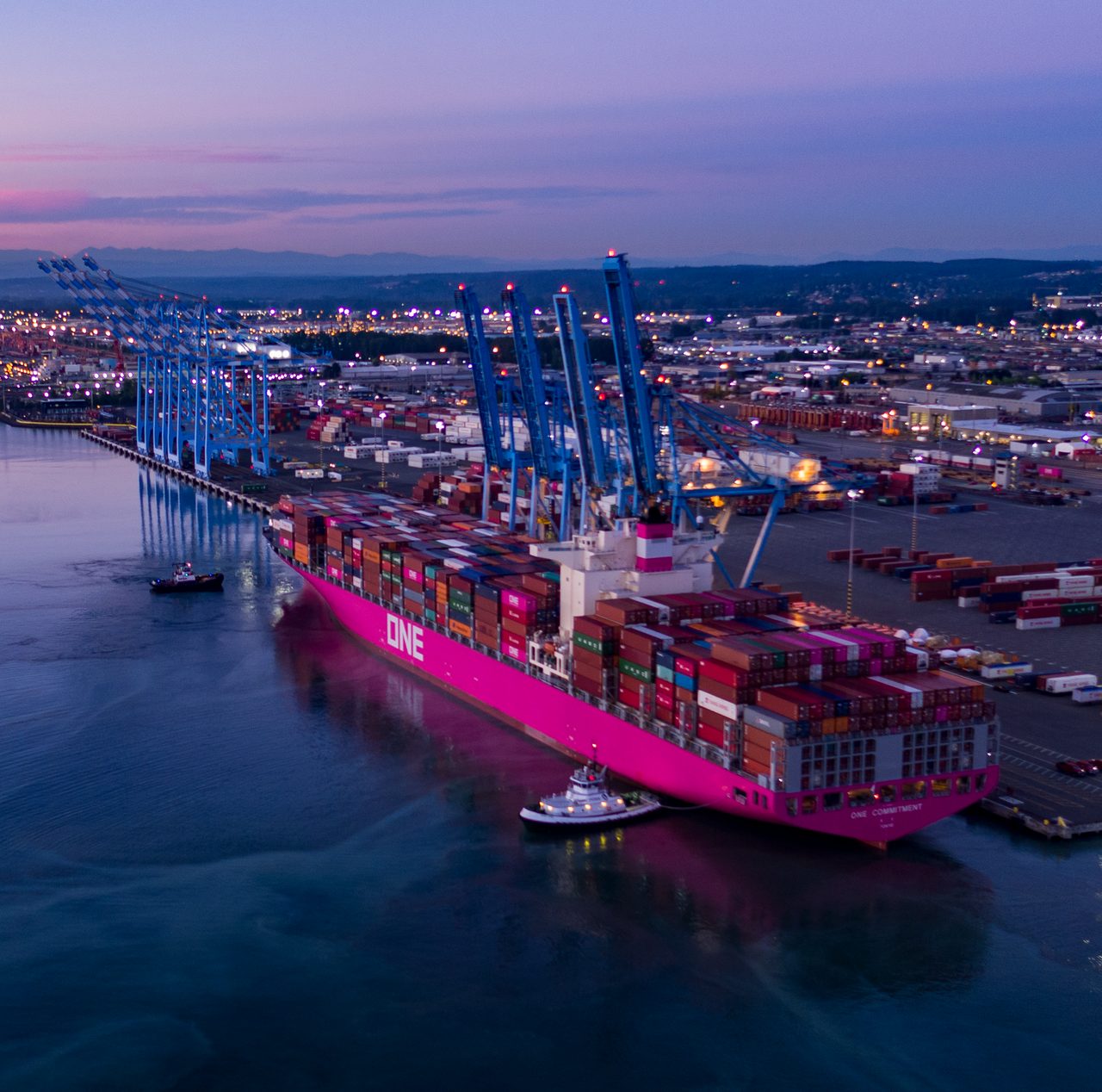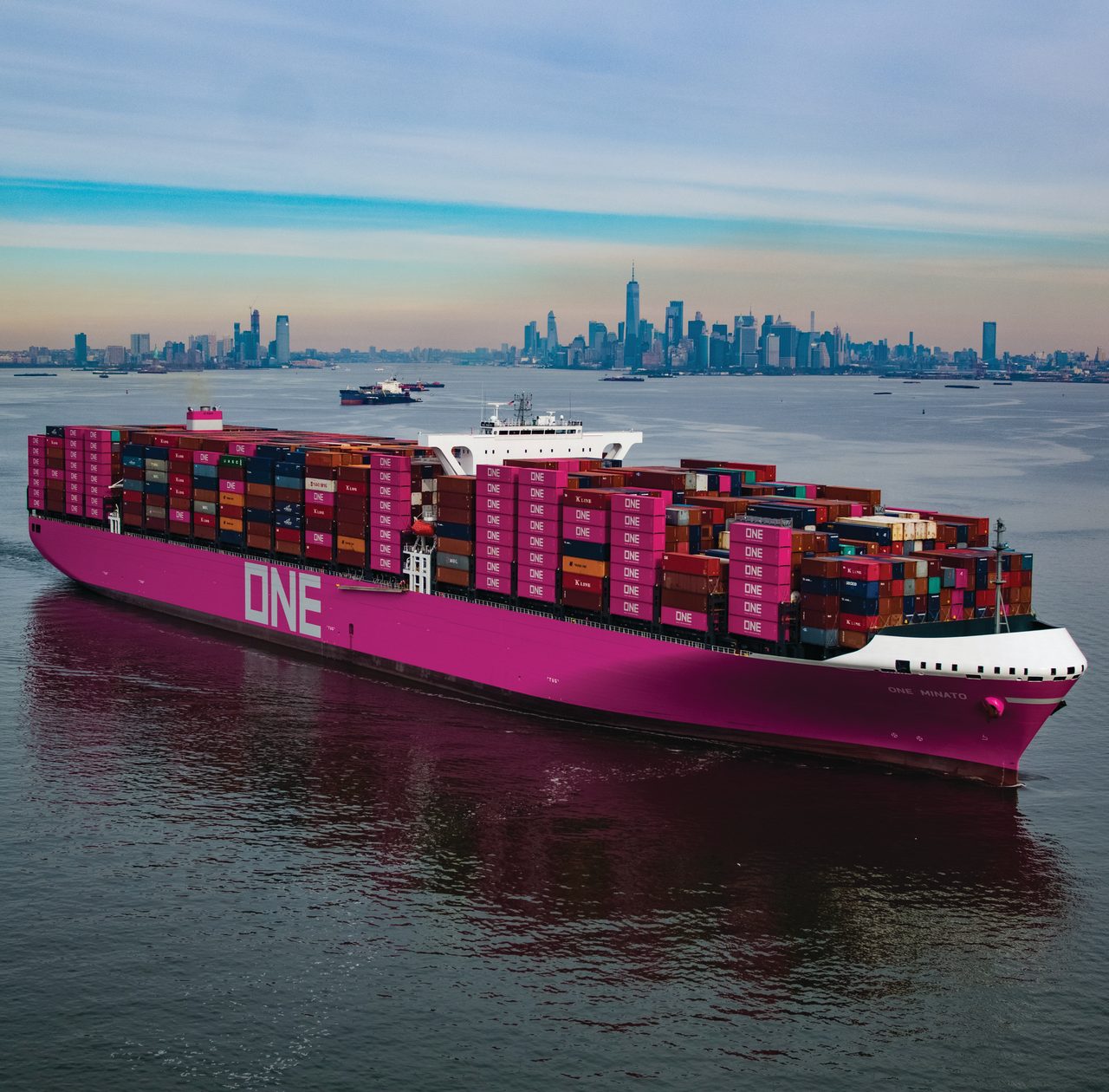
Charting a course to decarbonise shipping
As one of the world’s largest shipping companies, ONE plays a key role in reducing carbon emissions from global trade. Chief executive Jeremy Nixon says that deciding on the technology to do the job will take further R&D, but industry and regulators have the necessary resolve.
Reducing emissions, end to end
“A ship arrives in the US from Asia, fully loaded with containers” says Jeremy Nixon, chief executive of Ocean Network Express (ONE). “Probably 40% of those containers will go straight to a rail operation that heads off to the Midwest and the east-coast land bridge, using Chicago as a major rail hub-and-spoke operation. We’re moving product end to end, not just ship to ship or port to port. Those containers have to move round-trip across great ocean and landside distances, to and from factories, depots and distribution centres.”
The end-to-end nature of shipping, broadly construed, makes firms like ONE an integral part of businesses’ efforts to reduce their carbon footprint. During every part of the journey that goods make across countries, continents and the world, emissions can be reduced. But right now Mr Nixon and ONE, which is among the world’s top ten container-shipping companies by capacity, see the seafaring part of the journey as the major focus for shipping lines.
“Shipping globally is responsible for round about 2.5% of global greenhouse gases. And container shipping is probably about 30% of that,” says Mr Nixon. It could be tempting to dismiss the importance of that share, but that would be to ignore exponential growth in sea trade. Volumes have gone from well under a billion tonnes in 1900 to roughly 12 billion tonnes in 2018, carried by 60,000 ships powered by fossil fuels—of which ONE runs more than 250 of the largest and most efficient vessels.
Charting a course to decarbonise shipping
As one of the world’s largest shipping companies, ONE plays a key role in reducing carbon emissions from global trade. Chief executive Jeremy Nixon says that deciding on the technology to do the job will take further R&D, but industry and regulators have the necessary resolve.

Reducing emissions, end to end
“A ship arrives in the US from Asia, fully loaded with containers” says Jeremy Nixon, chief executive of Ocean Network Express (ONE). “Probably 40% of those containers will go straight to a rail operation that heads off to the Midwest and the east-coast land bridge, using Chicago as a major rail hub-and-spoke operation. We’re moving product end to end, not just ship to ship or port to port. Those containers have to move round-trip across great ocean and landside distances, to and from factories, depots and distribution centres.”
The end-to-end nature of shipping, broadly construed, makes firms like ONE an integral part of businesses’ efforts to reduce their carbon footprint. During every part of the journey that goods make across countries, continents and the world, emissions can be reduced. But right now Mr Nixon and ONE, which is among the world’s top ten container-shipping companies by capacity, see the seafaring part of the journey as the major focus for shipping lines.
“Shipping globally is responsible for round about 2.5% of global greenhouse gases. And container shipping is probably about 30% of that,” says Mr Nixon. It could be tempting to dismiss the importance of that share, but that would be to ignore exponential growth in sea trade. Volumes have gone from well under a billion tonnes in 1900 to roughly 12 billion tonnes in 2018, carried by 60,000 ships powered by fossil fuels—of which ONE runs more than 250 of the largest and most efficient vessels.
“We want to be able to say to our customers that there’s three or four different ways of routing. We can give you the lowest price option, the fastest transit time option or the lowest CO2 footprint option.”
three or four different ways
For sea trade to continue that trajectory without doing more to reduce carbon intensity would have seen emissions from the world’s cargo fleet reach around three billion tonnes of CO2 in 2050, compared to around 900 million as of 2008. Meanwhile, the International Maritime Organisation (IMO), the United Nations (UN) body overseeing shipping, has set a target to reduce the industry’s emissions by 50% in that same period, to a maximum cap of just 450 million tonnes of CO2.
“We’ve got to keep all this trade going, but somehow we’ve got to come up with a way of doing it where we’re not using [carbon-intensive] fuels anymore.” In that context, IMO oversight is a boon. “We’re really fortunate to have this single UN body to oversee our industry,” says Mr Nixon. “That should allow the industry and the regulator to adopt a standardised and rigorous global approach.”
The vast difference between projected shipping emissions and international targets 'defines the problem' for the industry”
- Jeremy Nixon
“
For sea trade to continue that trajectory without doing more to reduce carbon intensity would have seen emissions from the world’s cargo fleet reach around three billion tonnes of CO2 in 2050, compared to around 900 million as of 2008. Meanwhile, the International Maritime Organisation (IMO), the United Nations (UN) body overseeing shipping, has set a target to reduce the industry’s emissions by 50% in that same period, to a maximum cap of just 450 million tonnes of CO2.
“We’ve got to keep all this trade going, but somehow we’ve got to come up with a way of doing it where we’re not using [carbon-intensive] fuels anymore.” In that context, IMO oversight is a boon. “We’re really fortunate to have this single UN body to oversee our industry,” says Mr Nixon. “That should allow the industry and the regulator to adopt a standardised and rigorous global approach.”
The vast difference between projected shipping emissions and international targets 'defines the problem' for the industry”
- Jeremy Nixon
“
For sea trade to continue that trajectory without doing more to reduce carbon intensity would have seen emissions from the world’s cargo fleet reach around three billion tonnes of CO2 in 2050, compared to around 900 million as of 2008. Meanwhile, the International Maritime Organisation (IMO), the United Nations (UN) body overseeing shipping, has set a target to reduce the industry’s emissions by 50% in that same period, to a maximum cap of just 450 million tonnes of CO2.
“We’ve got to keep all this trade going, but somehow we’ve got to come up with a way of doing it where we’re not using [carbon-intensive] fuels anymore.” In that context, IMO oversight is a boon. “We’re really fortunate to have this single UN body to oversee our industry,” says Mr Nixon. “That should allow the industry and the regulator to adopt a standardised and rigorous global approach.”
The vast difference between projected shipping emissions and international targets 'defines the problem' for the industry”
- Jeremy Nixon
“


ONE COMMITMENT container ship at the Port of Tacoma, Washington.
ONE is among the world’s top ten container-shipping companies by capacity.
Choosing the right strategy to meet ambitious targets
At the 75th meeting of the IMO’s Marine Environment Protection Committee in 2020, delegates set both the 50% emission reduction target by 2050 and a shorter-term target of 40% by 2030. As they strive to reach these, shipping businesses have a range of strategies to put in play. Because shipping becomes less carbon-efficient at higher speeds, the shipping industry and its regulators are also considering reducing the speed of vessels to minimise their carbon intensity where retrofitting new technical solutions is not possible. The more energy-inefficient a ship is, the greater the limitations that will have to be imposed.
Already, for 2023 to 2028 it is expected that carbon intensity will have to be reduced by 3% per year. More regulatory tightening will undoubtedly follow.
3%
Large container vessels like those operated by ONE are still by far the most carbon-efficient way of transporting goods. On average, transporting a tonne of freight on a container vessel with a capacity of 18,000 twenty-foot equivalent units (TEUs) creates just three grams of CO2-equivalent emissions per tonne kilometre, less than a hundredth of the 435 grams it takes to transport a tonne by air. Part of this efficiency comes down to the Archimedes’ principle, a physical law that means larger vessels are more buoyant. So large ships are still the best choice for moving trade goods sustainably.
Shipping companies like ONE now find themselves squeezed between customer expectations about speed and cost, and regulation that mandates particular speeds at particular levels of efficiency. “ONE is working with customers to find the sweet spot,” says Mr Nixon. “We want to be able to say to our customers that there’s three or four different ways of routing. We can give you the lowest price option, the fastest transit time option or the lowest CO2 footprint option.” This mix of pressure from customers and regulators will give all parties involved in the industry, particularly shipowners and shipping lines like ONE, an incentive to favour larger vessels, make hull modifications, install energy-saving devices, and explore new and alternative fuel options.
“ONE is committed to doing this. We’ll find a way to get this to work, and we’ll put money towards it. Our customers are telling us they want to do it. Our children are telling us they want it. We need to do it.”
want to do it.
A shared resolve to make new technologies work
Alternative fuels each have their upsides and downsides. For example, electricity works well for ferries and other short, intercoastal routes, but battery technology has yet to develop sufficiently to power international shipping. “We did one calculation where, even after looking at improvements in the next five years, the battery would have to be the size of another ship,” says Mr Nixon.
Amongst other alternative fuels, biofuels are from renewable sources but are not particularly scalable, while ammonia is abundant and can be made using renewable energy sources, but offers lower energy density than fuel oil and is potentially deadly. As a liquid fuel that can be created using zero-emissions electricity, hydrogen is appealing, but takes four times the storage space of fuel oil. And liquefied natural gas (LNG), which is mainly methane, can reduce a ship’s CO2 footprint by 15% to 20%, but tends to leak into the atmosphere, presenting another potential source of greenhouse-gas emissions. Six nuclear power units—each the size of a room—could run a zero-carbon ship for 20 years without refuelling. But there are worries about nuclear. For example, if there was an accident and a nuclear-powered ship ended up at the bottom of the ocean.

ONE COMMITMENT container ship arriving in port.
The fuels that power shipping in the future will be those that can be scaled as quickly and safely as possible. “We need a lot of R&D funding. So where’s that coming from?” asks Mr Nixon. One proposal has been to create a “self-tax” on the shipping industry that would be given to a new International Maritime Research and Development Board, with the aim of collecting US$5 billion in funds to develop technology collectively.
Energy companies, ports and terminals, shipping companies, charterers and cargo-owners will all need to collaborate on implementing the technologies that prove most practical and effective. “I genuinely believe the industry is really committed to doing this,” says Mr Nixon. “ONE is committed to doing this. We’ll find a way to get this to work, and we’ll put money towards it. Our customers are telling us they want to do it. Our children are telling us they want it. We need to do it.”
Double-click to select video
Lorem ipsum dolor
Lorem ipsum dolor sit amet, consectetur adipiscing elit, sed do eiusmod tempor incididunt ut labore et dolore magna aliqua.
Lorem ipsum dolor sit amet, consectetur adipiscing elit, sed do eiusmod tempor incididunt ut.

1 Source: ONE deck p.7.
2. https://www.ics-shipping.org/press-release/shipping-industry-welcomes-imo-decision-to-give-further-consideration-to-usd-5-billion-fund-to-accelerate-decarbonisation/
3. Mr Nixon's remarks at the Economist Events Panel from World Ocean Summit Virtual Week: https://www.youtube.com/watch?v=JDwQmrUtKOc&t=727s
References

Learn more lorem ipsum dolores consectetur →

